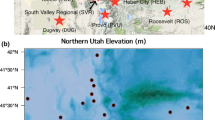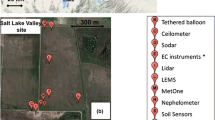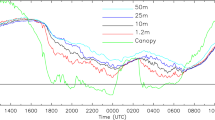Abstract
We investigated the spatiotemporal variability of surface meteorological variables in the nocturnal boundary layer using six automatic weather stations deployed in the Heber Valley, UT, during the MATERHORN-Fog experiment. The stations were installed on the valley floor within a 1.5 km × 0.8 km area and collected 1-Hz wind and pressure data and 0.2-Hz temperature and humidity data. We describe the weather stations and analyze the spatiotemporal variability of the measured variables during three nights with radiative cooling. Two nights were characterized by the presence of dense ice fog, one night with a persistent (‘heavy’) fog, and one with a short-lived (‘moderate’) fog, while the third night had no fog. Frost-point depressions were larger preceding the night without fog and showed a continued decrease during the no-fog night. On both fog nights, the frost-point depression reached values close to zero early in the night, but ~5 h earlier on the heavy-fog night than on the moderate-fog night. Spatial variability of temperature and humidity was smallest during the heavy-fog night and increased temporarily during short periods when wind speeds increased and the fog lifted. During all three nights, wind speeds did not exceed 2 m/s. The temporal variability of the wind speed and direction was larger during the fog nights than during the no-fog nights, but was particularly large during the heavy-fog night. The large variability corresponded with short-lived (5–10 min) pressure variations with amplitudes on the order of 0.5 hPa, indicating gravity wave activity. These pressure fluctuations occurred at all stations and were correlated in particular with variability in wind direction. Although not able to provide a complete picture of the nocturnal boundary layer, our low-cost weather stations were able to continuously collect data that were comparable to those of nearby research-grade instruments. From these data, we distinguished between fog and no-fog events, successfully quantified spatiotemporal variations in surface properties during these events, and detected gravity waves.








Similar content being viewed by others
References
Acevedo, O. C., & Fitzjarrald, D. R. (2001). The early evening surface-layer transition: Temporal and spatial variability. Journal of the Atmospheric Sciences, 58, 2650–2667.
Duynkerke, P. (1991). Observation of a quasi-periodic oscillation due to gravity-waves in a shallow radiation fog. Quarterly Journal Royal Meteorological Society, 117, 1207–1224.
Fernando, H. J. S., Pardyjak, E. R., Di Sabatino, S., Chow, F. K., De Wekker, S. F. J., Hoch, S. W., et al. (2015). The MATERHORN unraveling the intricacies of mountain weather. Bulletin of the American Meteorological Society, 96, U1–U24.
Fitzjarrald, D., & Lala, G. (1989). Hudson valley fog environments. Journal of Applied Meteorology, 28, 1303–1328.
Goswami, P., & Sarkar, S. (2015). Analysis and quantification of contrasts in observed meteorological fields for foggy and non-foggy days. Meteorology and Atmospheric Physics, 127, 605–623.
Gultepe, I., Fernando, H.J.S., Pardyjak, E.R., Hoch, S.W., Silver, Z., & Creegan, E., et al. (2016). An overview of the MATERHORN fog project: Observations and predictability. Pure and Applied Geophysics. doi:10.1007/s00024-016-1374-0 (this issue).
Gultepe, I., Tardif, R., Michaelides, S. C., Cermak, J., Bott, A., Bendix, J., et al. (2007). Fog research: A review of past achievements and future perspectives. Pure and Applied Geophysics, 164, 1121–1159.
Gultepe, I., Zhou, B., Milbrandt, J., Bott, A., Li, Y., Heymsfield, A. J., et al. (2015). A review on ice fog measurements and modeling. Atmospheric Research, 151, 2–19.
Hang, C., Nadeau, D.F., Gultepe, I., Hoch, S., Roman-Cascon, C., & Pryor, K., et al. (2016). A case study of the mechanisms modulating the evolution of valley fog. Pure and Applied Geophysics. doi:10.1007/s00024-016-1370-4 (this issue).
Hauf, T., Finke, U., Neisser, J., Gull, G., & Stangenberg, J. G. (1996). A ground-based network for atmospheric pressure fluctuations. Journal of Atmospheric and Oceanic Technology, 13, 1001–1023.
Mahrt, L., Richardson, S., Seaman, N., & Stauffer, D. (2010). Non-stationary drainage flows and motions in the cold pool. Tellus Series A: Dynamic Meteorology and Oceanography, 62, 698–705.
Makkonen, L., Lehtonen, P., & Helle, L. (2001). Anemometry in icing conditions. Journal of Atmospheric and Oceanic Technology, 18, 1457–1469.
Meyer, M., Lala, G., & Jiusto, J. (1986). Fog-82 - a cooperative field-study of radiation fog. Bulletin of the American Meteorological Society, 67, 825–832.
Nappo, C. J. (2012). An introduction to atmospheric gravity waves. New York: Academic Press.
Roach, W., Brown, R., Caughey, S., Garland, J., & Readings, C. (1976). Physics of radiation fog. 1. Field-study. Quarterly Journal Royal Meteorological Society, 102, 313–333.
Steeneveld, G. J., Ronda, R. J., & Holtslag, A. A. M. (2015). The challenge of forecasting the onset and development of radiation fog using mesoscale atmospheric models. Boundary-Layer Meteorology, 154, 265–289.
Strangeways, I. (1981). Instruments for mountainous areas. Nordic Hydrology, 12, 289–296.
Sun, J., Nappo, C. J., Mahrt, L., Belusic, D., Grisogono, B., Stauffer, D. R., et al. (2015). Review of wave-turbulence interactions in the stable atmospheric boundary layer. Reviews of Geophysics, 53, 956–993.
Underwood, S. J., Ellrod, G. P., & Kuhnert, A. L. (2004). A multiple-case analysis of nocturnal radiation-fog development in the Central Valley of California utilizing the GOES nighttime fog product. Journal of Applied Meteorology, 43, 297–311.
van der Velde, I. R., Steeneveld, G. J., Schreur, B. G. J. W., & Holtslag, A. A. M. (2010). Modeling and forecasting the onset and duration of severe radiation fog under frost conditions. Monthly Weather Review, 138, 4237–4253.
Welch, R., Ravichandran, M., & Cox, S. (1986). Prediction of quasi-periodic oscillations in radiation fogs. 1. Comparison of simple similarity approaches. Journal of the Atmospheric Sciences, 43, 633–651.
World Meteorological Organization (WMO) (2008). Guide to meteorological instruments and methods of observation. Appendix 4B, WMO-No. 8 (CIMO Guide), Geneva.
Zhou, B., & Du, J. (2010). Fog prediction from a multimodel mesoscale ensemble prediction system. Weather Forecasting, 25, 303–322.
Acknowledgments
The MATERHORN Program was funded by the Office of Naval Research (MURI) Award N00014-11-1-0709 (Program Officers: Drs. Ronald Ferek and Daniel Eleuterio). We would like to thank Nathan Rose for help in the design and assembly of the weather stations, Chaoxun Hang for his invaluable field assistance and for providing us with the visibility and UU-tower data, Eric Pardyjak for his help in site selection, Sandip Pal for taking down the weather stations, and Ismail Gultepe for his encouragements to submit a paper to this special issue and for his helpful comments.
Author information
Authors and Affiliations
Corresponding author
Rights and permissions
About this article
Cite this article
van den Bossche, M., De Wekker, S.F.J. Spatiotemporal Variability of Surface Meteorological Variables During Fog and No-Fog Events in the Heber Valley, UT; Selected Case Studies From MATERHORN-Fog. Pure Appl. Geophys. 173, 3031–3048 (2016). https://doi.org/10.1007/s00024-016-1352-6
Received:
Revised:
Accepted:
Published:
Issue Date:
DOI: https://doi.org/10.1007/s00024-016-1352-6




